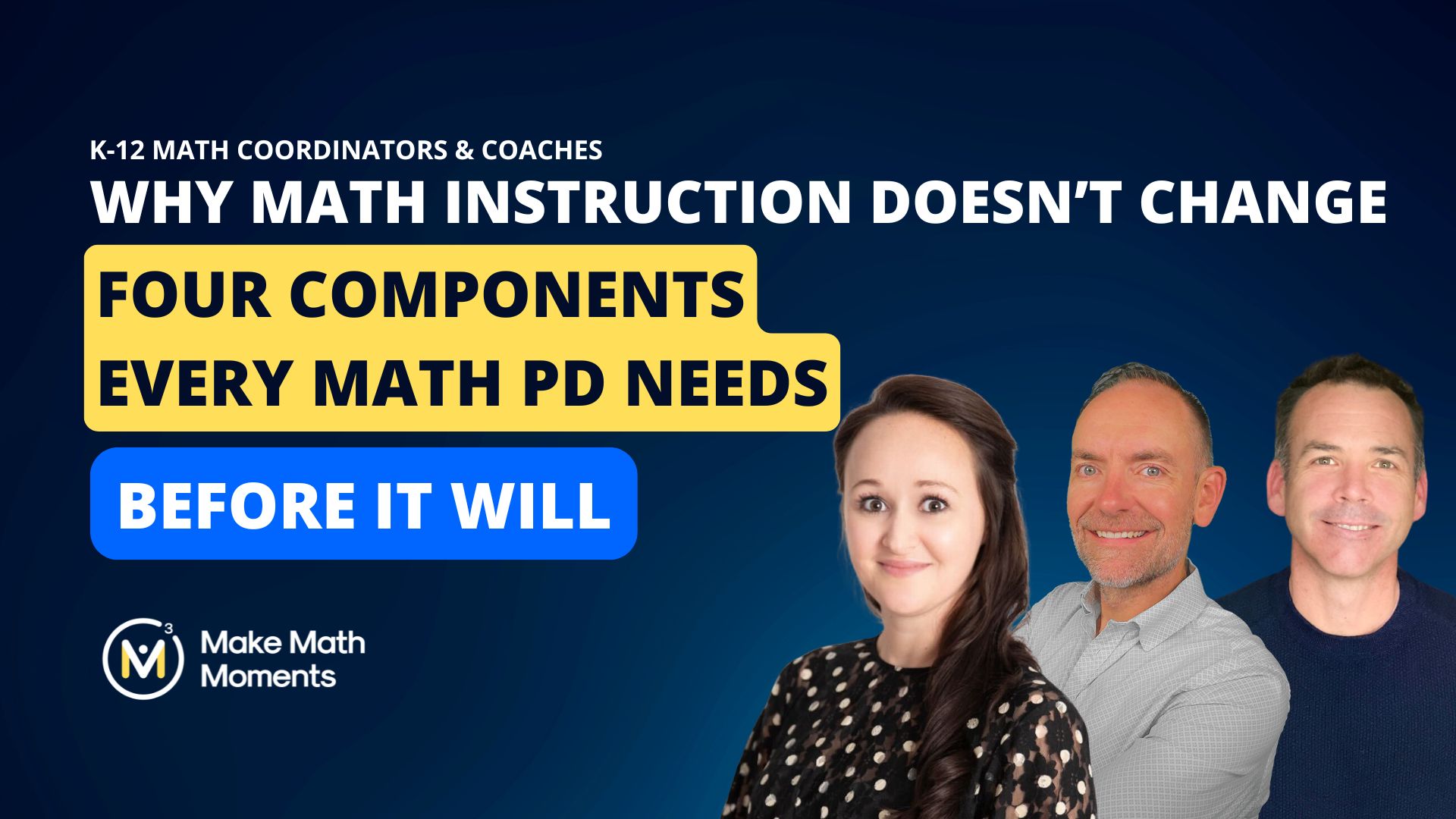In early 2023, Christine Dale and the math leadership team at Huron-Perth Catholic District School Board (HPCDSB) in rural Ontario found themselves staring down a problem almost every district eventually faces:
They were working hard. Their teachers were working hard. Their coaches were working hard.
But math instruction… wasn’t really changing.
Despite investing in coaching, running PD sessions, and rolling out research-aligned routines, the needle wasn’t moving as expected.
Christine put it simply:
“We were asking teachers to take on ambitious practices — but we weren’t giving them the ongoing, embedded support to be successful.”
And she was right.
What happened in Huron-Perth is not unique—it’s predictable.
Because most districts, without realizing it, try to build deep instructional change on a shallow support system.
I want to share the lesson Christine and the HPCDSB team learned—and the four components every district must have in place before teachers can sustain any instructional shift.
The Hidden Reason Math PD Doesn’t Stick
Huron-Perth was attempting to launch a two-day instructional model:
- Day 1: A problem-based lesson
- Day 2: Purposeful practice and small-group support
In theory, this structure is powerful.
In practice? Their existing coaching model couldn’t support it.
Coaches served multiple schools. They often visited a teacher on Day 1 and then didn’t return for Day 2 because they needed to move to a new school or classroom to support another teacher. Or they’d show up on Day 2 without seeing Day 1. The calendar—not instructional needs—determined their presence.
And when coaching becomes fragmented, implementation becomes fragmented.
This pattern happens everywhere:
- A great PD day creates excitement
- Coaches give a little follow-up
- Teachers try a strategy… but hit a roadblock
- Support arrives too late or not at all
- Teachers revert to what they know
- Leaders assume the strategy “didn’t work”
- The district moves on to the next initiative
…and the flywheel starts over.
The real issue?
Exposure is not support.
You can’t achieve deep instructional change with drive-by coaching, one-off PD events, or strategies teachers rarely see modeled in real classrooms.
And research backs this up—loudly.
The Research: Why Teachers Need More Than Math PD Events
For decades, Joyce & Showers have studied what actually leads teachers to implement new practices:
- Workshop alone: 5–10% of teachers use the strategy
- Workshop + coaching: 80–90% implement the strategy
Let that sink in.
A system that relies on PD events—no matter how inspiring—will fail nine times out of ten.
Similarly, Darling-Hammond et al. found that 49 hours of well-designed PD yield measurable changes in instruction and student outcomes.
The average teacher receives less than half that amount—and only a small fraction is tied to actual instructional improvement.
Huron-Perth was no exception. They had passion. They had effort. They had clarity.
But they didn’t have structure….yet.
The Shift That Changed Math PD & Support
After stepping back to analyze the problem, Christine and her team didn’t abandon their goals—they redesigned their support system.
Instead of coaches floating between sites, they created:
- Two consecutive days of in-class coaching
- Co-planning, co-teaching, and co-reflection cycles
- A clarified math block
- Lesson exemplars that matched their model
- A focus on trust before technique
They stopped asking coaches to be everywhere—and instead allowed them to be effective somewhere.
Teachers began opening up. Trust deepened. Teachers took risks they wouldn’t have taken alone. And students began experiencing more consistent, conceptually driven instruction.
It wasn’t a new initiative that changed results.
It was a new system.
The Four Components Math Teachers Need for Real Instructional Change
Through work with districts across North America—and backed by decades of research—we’ve found that teachers need four conditions before any new math practice actually sticks.
If even one of these is missing, implementation stalls.
1. Alignment With a Shared Math Vision
Teachers cannot implement what they do not understand.
They need a clear, consistently reinforced understanding of:
- What high-quality math instruction looks like
- Why the district is prioritizing certain math practices
- How these practices support their students
- How PD, coaching, PLCs, and leadership messages connect
When alignment is strong, teachers feel clarity, not confusion.
When alignment is weak, everything feels like “one more thing.”
Coherence creates staying power.
2. Opportunities to Experience and Observe the Math Practice
Hearing about a strategy is not enough.
Teachers need to feel it and see it.
The most effective systems provide:
- Modeling in PD sessions
- Learning labs
- Co-teaching
- Classroom video analysis
- Real-time observation cycles
- Student work protocols
When teachers experience a math instructional strategy as learners, the “why” becomes obvious.
When they see it with students, the “how” becomes actionable.
This is the difference between theoretical understanding and lived understanding.
3. Belief in Their Ability to Implement
Math Teachers need more than knowledge—they need confidence.
Belief grows when teachers have:
- Time to rehearse
- Collaborative planning
- Gentle coaching during real lessons
- Peers who are also learning
- A safe environment to try, fail, and try again
If math teachers don’t believe they can do something, they won’t—no matter how good the math PD was.
Belief is built through supported action, not inspirational messaging.
4. Ongoing Support and Follow-Up
This is the most important—and the most frequently missing—component.
A strategy only takes root when math teachers receive:
- Ongoing math coaching
- Math PLC alignment
- Reinforcement tools
- Leadership follow-up
- Data reflection cycles
- Multiple opportunities to revisit the practice
Without sustained support, math teachers revert to familiar habits.
With sustained support, new habits become instructional culture.
The Takeaway: Ideas Don’t Create Change. Systems Do.
The story of Huron-Perth is not a story about failure—it’s a story about clarity.
They realized something most districts never pause long enough to see:
You can’t build deep instructional change in math on a shallow support system.
And most districts—maybe yours—unknowingly try anyway.
The four components above are not “nice-to-haves.”
They are not “advanced moves.”
They are not “one day when we have time.”
They are the conditions required for any math initiative to survive contact with the day-to-day realities of classroom life.
Before You Plan Your Next Math Initiative, Ask Yourself:
Do math teachers understand how this connects to our vision (you have a vision right?)?
Have they seen the strategy in real classrooms?
Do they believe they can do it?
Do we have the structures to support them all year long?
If not, don’t expect miracles to happen in 1 year, 2 years, 5 years.
Because without these four components, even your strongest goals will stall—and your flywheel will reset every year.
But with them?
Your flywheel begins to turn itself.
Want to Learn More?
At Make Math Moments, we help districts build systems for sustainable improvement through our Math Improvement Flywheel—a four-stage process that supports leaders in designing vision, aligning systems, building capacity, and inspiring growth.
If your district is ready to move beyond short-term fixes and ensure the 4 components of adoption are embedded in your system, we’d love to partner with you. 👉 Learn more about the District/School Improvement Program.






